Yunxiang Li
STPNet: Scale-aware Text Prompt Network for Medical Image Segmentation
Apr 02, 2025Abstract:Accurate segmentation of lesions plays a critical role in medical image analysis and diagnosis. Traditional segmentation approaches that rely solely on visual features often struggle with the inherent uncertainty in lesion distribution and size. To address these issues, we propose STPNet, a Scale-aware Text Prompt Network that leverages vision-language modeling to enhance medical image segmentation. Our approach utilizes multi-scale textual descriptions to guide lesion localization and employs retrieval-segmentation joint learning to bridge the semantic gap between visual and linguistic modalities. Crucially, STPNet retrieves relevant textual information from a specialized medical text repository during training, eliminating the need for text input during inference while retaining the benefits of cross-modal learning. We evaluate STPNet on three datasets: COVID-Xray, COVID-CT, and Kvasir-SEG. Experimental results show that our vision-language approach outperforms state-of-the-art segmentation methods, demonstrating the effectiveness of incorporating textual semantic knowledge into medical image analysis. The code has been made publicly on https://github.com/HUANGLIZI/STPNet.
ReMA: Learning to Meta-think for LLMs with Multi-Agent Reinforcement Learning
Mar 12, 2025Abstract:Recent research on Reasoning of Large Language Models (LLMs) has sought to further enhance their performance by integrating meta-thinking -- enabling models to monitor, evaluate, and control their reasoning processes for more adaptive and effective problem-solving. However, current single-agent work lacks a specialized design for acquiring meta-thinking, resulting in low efficacy. To address this challenge, we introduce Reinforced Meta-thinking Agents (ReMA), a novel framework that leverages Multi-Agent Reinforcement Learning (MARL) to elicit meta-thinking behaviors, encouraging LLMs to think about thinking. ReMA decouples the reasoning process into two hierarchical agents: a high-level meta-thinking agent responsible for generating strategic oversight and plans, and a low-level reasoning agent for detailed executions. Through iterative reinforcement learning with aligned objectives, these agents explore and learn collaboration, leading to improved generalization and robustness. Experimental results demonstrate that ReMA outperforms single-agent RL baselines on complex reasoning tasks, including competitive-level mathematical benchmarks and LLM-as-a-Judge benchmarks. Comprehensive ablation studies further illustrate the evolving dynamics of each distinct agent, providing valuable insights into how the meta-thinking reasoning process enhances the reasoning capabilities of LLMs.
Generate, Discriminate, Evolve: Enhancing Context Faithfulness via Fine-Grained Sentence-Level Self-Evolution
Mar 03, 2025Abstract:Improving context faithfulness in large language models is essential for developing trustworthy retrieval augmented generation systems and mitigating hallucinations, especially in long-form question answering (LFQA) tasks or scenarios involving knowledge conflicts. Existing methods either intervene LLMs only at inference without addressing their inherent limitations or overlook the potential for self-improvement. In this paper, we introduce GenDiE (Generate, Discriminate, Evolve), a novel self-evolving framework that enhances context faithfulness through fine-grained sentence-level optimization. GenDiE combines both generative and discriminative training, equipping LLMs with self-generation and self-scoring capabilities to facilitate iterative self-evolution. This supports both data construction for model alignment and score-guided search during inference. Furthermore, by treating each sentence in a response as an independent optimization unit, GenDiE effectively addresses the limitations of previous approaches that optimize at the holistic answer level, which may miss unfaithful details. Experiments on ASQA (in-domain LFQA) and ConFiQA (out-of-domain counterfactual QA) datasets demonstrate that GenDiE surpasses various baselines in both faithfulness and correctness, and exhibits robust performance for domain adaptation.
Devising a Set of Compact and Explainable Spoken Language Feature for Screening Alzheimer's Disease
Nov 28, 2024



Abstract:Alzheimer's disease (AD) has become one of the most significant health challenges in an aging society. The use of spoken language-based AD detection methods has gained prevalence due to their scalability due to their scalability. Based on the Cookie Theft picture description task, we devised an explainable and effective feature set that leverages the visual capabilities of a large language model (LLM) and the Term Frequency-Inverse Document Frequency (TF-IDF) model. Our experimental results show that the newly proposed features consistently outperform traditional linguistic features across two different classifiers with high dimension efficiency. Our new features can be well explained and interpreted step by step which enhance the interpretability of automatic AD screening.
Single-Point Supervised High-Resolution Dynamic Network for Infrared Small Target Detection
Aug 04, 2024



Abstract:Infrared small target detection (IRSTD) tasks are extremely challenging for two main reasons: 1) it is difficult to obtain accurate labelling information that is critical to existing methods, and 2) infrared (IR) small target information is easily lost in deep networks. To address these issues, we propose a single-point supervised high-resolution dynamic network (SSHD-Net). In contrast to existing methods, we achieve state-of-the-art (SOTA) detection performance using only single-point supervision. Specifically, we first design a high-resolution cross-feature extraction module (HCEM), that achieves bi-directional feature interaction through stepped feature cascade channels (SFCC). It balances network depth and feature resolution to maintain deep IR small-target information. Secondly, the effective integration of global and local features is achieved through the dynamic coordinate fusion module (DCFM), which enhances the anti-interference ability in complex backgrounds. In addition, we introduce the high-resolution multilevel residual module (HMRM) to enhance the semantic information extraction capability. Finally, we design the adaptive target localization detection head (ATLDH) to improve detection accuracy. Experiments on the publicly available datasets NUDT-SIRST and IRSTD-1k demonstrate the effectiveness of our method. Compared to other SOTA methods, our method can achieve better detection performance with only a single point of supervision.
STS MICCAI 2023 Challenge: Grand challenge on 2D and 3D semi-supervised tooth segmentation
Jul 18, 2024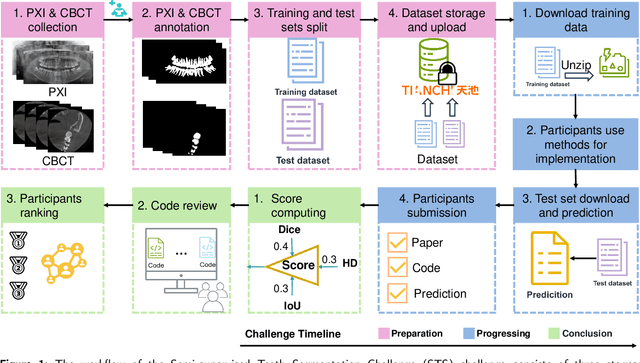


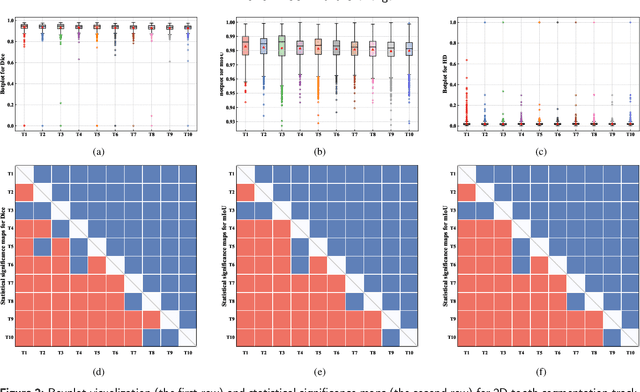
Abstract:Computer-aided design (CAD) tools are increasingly popular in modern dental practice, particularly for treatment planning or comprehensive prognosis evaluation. In particular, the 2D panoramic X-ray image efficiently detects invisible caries, impacted teeth and supernumerary teeth in children, while the 3D dental cone beam computed tomography (CBCT) is widely used in orthodontics and endodontics due to its low radiation dose. However, there is no open-access 2D public dataset for children's teeth and no open 3D dental CBCT dataset, which limits the development of automatic algorithms for segmenting teeth and analyzing diseases. The Semi-supervised Teeth Segmentation (STS) Challenge, a pioneering event in tooth segmentation, was held as a part of the MICCAI 2023 ToothFairy Workshop on the Alibaba Tianchi platform. This challenge aims to investigate effective semi-supervised tooth segmentation algorithms to advance the field of dentistry. In this challenge, we provide two modalities including the 2D panoramic X-ray images and the 3D CBCT tooth volumes. In Task 1, the goal was to segment tooth regions in panoramic X-ray images of both adult and pediatric teeth. Task 2 involved segmenting tooth sections using CBCT volumes. Limited labelled images with mostly unlabelled ones were provided in this challenge prompt using semi-supervised algorithms for training. In the preliminary round, the challenge received registration and result submission by 434 teams, with 64 advancing to the final round. This paper summarizes the diverse methods employed by the top-ranking teams in the STS MICCAI 2023 Challenge.
Multi-Level Feature Fusion Network for Lightweight Stereo Image Super-Resolution
May 09, 2024Abstract:Stereo image super-resolution utilizes the cross-view complementary information brought by the disparity effect of left and right perspective images to reconstruct higher-quality images. Cascading feature extraction modules and cross-view feature interaction modules to make use of the information from stereo images is the focus of numerous methods. However, this adds a great deal of network parameters and structural redundancy. To facilitate the application of stereo image super-resolution in downstream tasks, we propose an efficient Multi-Level Feature Fusion Network for Lightweight Stereo Image Super-Resolution (MFFSSR). Specifically, MFFSSR utilizes the Hybrid Attention Feature Extraction Block (HAFEB) to extract multi-level intra-view features. Using the channel separation strategy, HAFEB can efficiently interact with the embedded cross-view interaction module. This structural configuration can efficiently mine features inside the view while improving the efficiency of cross-view information sharing. Hence, reconstruct image details and textures more accurately. Abundant experiments demonstrate the effectiveness of MFFSSR. We achieve superior performance with fewer parameters. The source code is available at https://github.com/KarosLYX/MFFSSR.
NTIRE 2024 Challenge on Low Light Image Enhancement: Methods and Results
Apr 22, 2024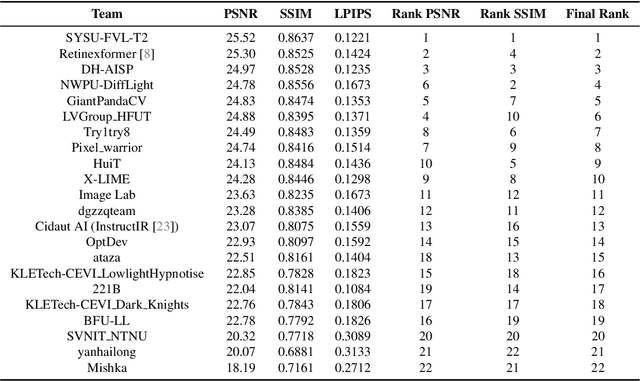

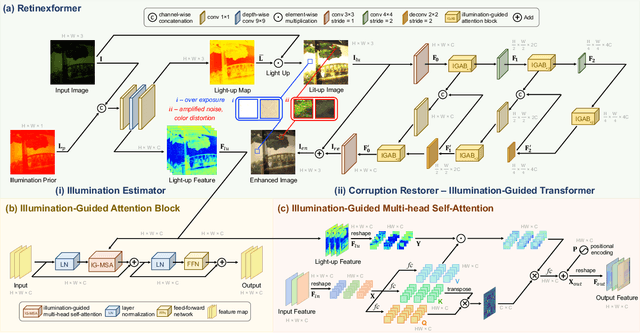

Abstract:This paper reviews the NTIRE 2024 low light image enhancement challenge, highlighting the proposed solutions and results. The aim of this challenge is to discover an effective network design or solution capable of generating brighter, clearer, and visually appealing results when dealing with a variety of conditions, including ultra-high resolution (4K and beyond), non-uniform illumination, backlighting, extreme darkness, and night scenes. A notable total of 428 participants registered for the challenge, with 22 teams ultimately making valid submissions. This paper meticulously evaluates the state-of-the-art advancements in enhancing low-light images, reflecting the significant progress and creativity in this field.
Enhancing Policy Gradient with the Polyak Step-Size Adaption
Apr 11, 2024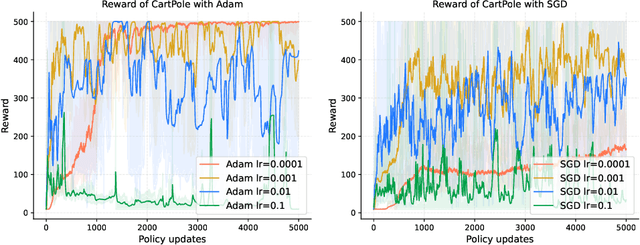
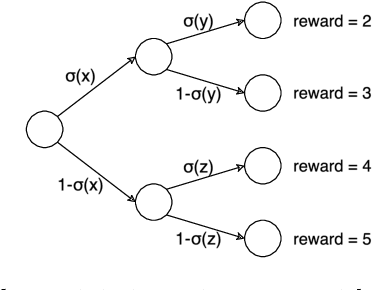
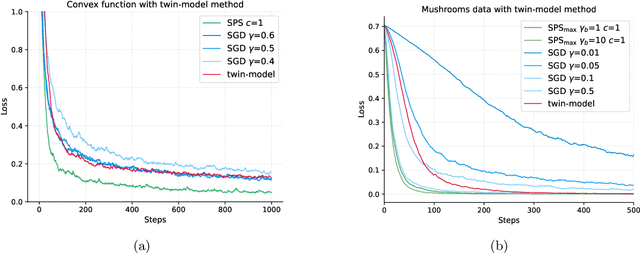

Abstract:Policy gradient is a widely utilized and foundational algorithm in the field of reinforcement learning (RL). Renowned for its convergence guarantees and stability compared to other RL algorithms, its practical application is often hindered by sensitivity to hyper-parameters, particularly the step-size. In this paper, we introduce the integration of the Polyak step-size in RL, which automatically adjusts the step-size without prior knowledge. To adapt this method to RL settings, we address several issues, including unknown f* in the Polyak step-size. Additionally, we showcase the performance of the Polyak step-size in RL through experiments, demonstrating faster convergence and the attainment of more stable policies.
Prior Frequency Guided Diffusion Model for Limited Angle (LA)-CBCT Reconstruction
Apr 09, 2024Abstract:Cone-beam computed tomography (CBCT) is widely used in image-guided radiotherapy. Reconstructing CBCTs from limited-angle acquisitions (LA-CBCT) is highly desired for improved imaging efficiency, dose reduction, and better mechanical clearance. LA-CBCT reconstruction, however, suffers from severe under-sampling artifacts, making it a highly ill-posed inverse problem. Diffusion models can generate data/images by reversing a data-noising process through learned data distributions; and can be incorporated as a denoiser/regularizer in LA-CBCT reconstruction. In this study, we developed a diffusion model-based framework, prior frequency-guided diffusion model (PFGDM), for robust and structure-preserving LA-CBCT reconstruction. PFGDM uses a conditioned diffusion model as a regularizer for LA-CBCT reconstruction, and the condition is based on high-frequency information extracted from patient-specific prior CT scans which provides a strong anatomical prior for LA-CBCT reconstruction. Specifically, we developed two variants of PFGDM (PFGDM-A and PFGDM-B) with different conditioning schemes. PFGDM-A applies the high-frequency CT information condition until a pre-optimized iteration step, and drops it afterwards to enable both similar and differing CT/CBCT anatomies to be reconstructed. PFGDM-B, on the other hand, continuously applies the prior CT information condition in every reconstruction step, while with a decaying mechanism, to gradually phase out the reconstruction guidance from the prior CT scans. The two variants of PFGDM were tested and compared with current available LA-CBCT reconstruction solutions, via metrics including PSNR and SSIM. PFGDM outperformed all traditional and diffusion model-based methods. PFGDM reconstructs high-quality LA-CBCTs under very-limited gantry angles, allowing faster and more flexible CBCT scans with dose reductions.
 Add to Chrome
Add to Chrome Add to Firefox
Add to Firefox Add to Edge
Add to Edge